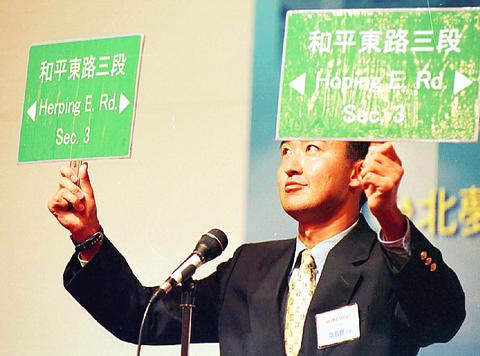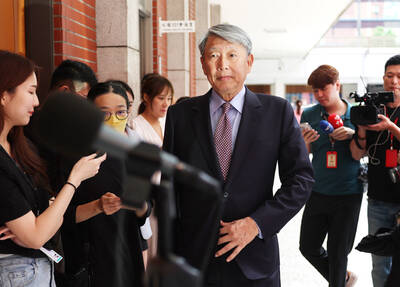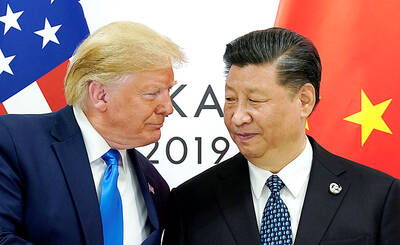The embattled Yu Bor-chuan (
During the conversation, the researcher shared with the Taipei Times the motivation behind the Tongyong Pinyin system and detailed the reasons why he believes it is a better system than China's Hanyu Pinyin (漢語拼音) for adoption in Taiwan. Most importantly, he seized the opportunity to clarify some of the issues at the heart of what he said were public misconceptions about the Tongyong system.
The 43-year-old Yu is a socio-linguist who has devoted himself for years to research interpretation and translation between English and Mandarin.

FILE PHOTO: CHIANG YING-YING, TAIPEI TIMES
Taipei Times: What led your team to invent the Tongyong Pinyin system?
Yu Bor-chuan: Inconsistencies in Mandarin Romanization have long been a contentious issue in Taiwan. Aware of the gravity of the matter and the urgency of forging an official policy, Chen Shui-bian (陳水扁), Taipei's mayor at the time, commissioned the Association of Interpretation and Translation (中華民國翻譯協會) in 1997 to standardize Mandarin Romanization for the streets of Taipei.
As a director of the association I became involved. After embarking on a series of studies, we [my teammates and myself] came to the conclusion that China's Hanyu Pinyin system was imperfect in many respects and, more significantly, that there were many aspects of the pronunciation of the assorted tongues spoken by natives of Taiwan with which it did not accord. Both of these reasons prompted my invention of the Tongyong Pinyin system.
From my point of view, Tongyong Pinyin was developed to achieve an optimal balance between internationalization and national autonomy. It will be a system accepted most easily and quickly by Taiwanese.
TT: The decision made by the Ministry of Education last Saturday to adopt the Tongyong system has sparked heated public debate. Some argue that "globalization" should be a major concern, saying that employing the Tongyong system will confuse foreigners and weaken the competitiveness of Taiwan in the international community. How do you respond to such criticism?
Yu: To achieve the goal of globalization, socio-linguists also aim to respect the heritage of minority groups.
Consider the English language, for example. Being an international language, English can be spelled and used differently from country to country. English spoken in the United Kingdom is not totally identical to that in the US, whereas Australian English has much distinctive usage that cannot be found in either the UK or the US. The differences in the use of English among these countries may be rather subtle, yet they all retain their own unique qualities.
In addition, the Cantonese Romanization system used in Hong Kong is also different from the "Cantonese spelling system" designated by the Chinese government, because Hong Kong residents have their own stance on how to normalize the spelling system of their language. Why can we not do the same to Mandarin in Taiwan?
Anyone who retains a fundamental understanding of international languages will respect Taiwan adopting its own Romanization system. To say that Taiwan will be isolated from the international community if it chooses to use the Tongyong system is to lack a full understanding of what the Tongyong system is.
In fact, the Hanyu and Tongyong systems are 85 percent similar. For the remaining 15 percent, I have improved morphemes in Hanyu Pinyin that are apparently considered flawed. With a little time and patience, learners will agree that Tongyong is user-friendly because they only have to learn four principles by heart to master the system.
Tongyong is not meant to compete with Hanyu or to replace it. The two systems can co-exist without coming into conflict.
I believe that embracing the Hanyu Pinyin system is not Taiwan's only means of keeping pace with globalization. By means of promotion by governmental departments, I believe Tongyong can also be accepted by the international community.
TT: You said you had found that the Hanyu Pinyin system was problematic in several respects. Can you give us examples? Also, would you elaborate on how Tongyong is a better system than Hanyu Pinyin when learning the languages spoken in Taiwan?
Yu: For example, "翁" is represented as "wong" in Tongyong, whereas it is spelled "weng" in Hanyu Pinyin. "Ong," rather than "eng" is a closer approximation to the phonetic value of the morphemes in the languages spoken in Taiwan.
There are three different signs in Hanyu Pinyin for the morpheme "
Furthermore, "
Another instance is that, in Hanyu, "ㄅ" is represented as "bi," while "ㄆ" is "pi." By the same token, you would assume "ㄒ" would be romanized as "si." But it is not. "Si" in Hanyu refers to the "ㄙ" sound, which is in conflict with speakers' intuitive expectations. In Hokkien, it would be easier and more natural sounding to employ the Tongyong system. "Si-gue" means watermelon, whereas "sin-iong" refers to religious belief.
As for the teaching and learning of Hakka, there is 90 percent compatibility between Tongyong and Hakka. In other words, if one knows Tongyong Pinyin one will encounter no obstacles to learning Hakka.
TT: In terms of the differences between the Tongyong and Hanyu systems, many Chinese-language newspapers have stated that the primary distinction between the two is that the former includes many local dialects and usage that would confuse foreigners. Do you consider this a fair statement?
Yu: I would like to take the chance to correct several false impressions of the Tongyong system.
Opponents of the system always cite examples of "Manka" (萬華), "Sulim," (士林) and Paronpon Street (大龍街) in Taipei City as evidence that Tongyong is a baffling system for foreign visitors because they have no background knowledge of Taiwan's history and culture.
One must understand, however, that of the more than 600 streets in Taipei, we suggested restoration of the ancient names for merely seven or eight streets, which accounts for about 1 percent of the total. For the remaining streets, the names remain absolutely unchanged. At a time when the cultural heritages of non-mainstream groups are on the verge of extinction, we consider it part of our mission to retain the names given by the Plain's Aborigines (
If people find these historic names perplexing, we do not object to using both historic and modern names. As long as maps and street signs take the same name, I am sure there would be no confusion. The most important point is standardization, how to spell is a matter of habit.

In his National Day Rally speech on Sunday, Singaporean Prime Minister Lawrence Wong (黃循財) quoted the Taiwanese song One Small Umbrella (一支小雨傘) to describe his nation’s situation. Wong’s use of such a song shows Singapore’s familiarity with Taiwan’s culture and is a perfect reflection of exchanges between the two nations, Representative to Singapore Tung Chen-yuan (童振源) said yesterday in a post on Facebook. Wong quoted the song, saying: “As the rain gets heavier, I will take care of you, and you,” in Mandarin, using it as a metaphor for Singaporeans coming together to face challenges. Other Singaporean politicians have also used Taiwanese songs

NORTHERN STRIKE: Taiwanese military personnel have been training ‘in strategic and tactical battle operations’ in Michigan, a former US diplomat said More than 500 Taiwanese troops participated in this year’s Northern Strike military exercise held at Lake Michigan by the US, a Pentagon-run news outlet reported yesterday. The Michigan National Guard-sponsored drill involved 7,500 military personnel from 36 nations and territories around the world, the Stars and Stripes said. This year’s edition of Northern Strike, which concluded on Sunday, simulated a war in the Indo-Pacific region in a departure from its traditional European focus, it said. The change indicated a greater shift in the US armed forces’ attention to a potential conflict in Asia, it added. Citing a briefing by a Michigan National Guard senior

CHIPMAKING INVESTMENT: J.W. Kuo told legislators that Department of Investment Review approval would be needed were Washington to seek a TSMC board seat Minister of Economic Affairs J.W. Kuo (郭智輝) yesterday said he received information about a possible US government investment in Taiwan Semiconductor Manufacturing Co (TSMC, 台積電) and an assessment of the possible effect on the firm requires further discussion. If the US were to invest in TSMC, the plan would need to be reviewed by the Department of Investment Review, Kuo told reporters ahead of a hearing of the legislature’s Economics Committee. Kuo’s remarks came after US Secretary of Commerce Howard Lutnick on Tuesday said that the US government is looking into the federal government taking equity stakes in computer chip manufacturers that

US President Donald Trump on Friday said that Chinese President Xi Jinping (習近平) told him China would not invade Taiwan while Trump is in office. Trump made the remarks in an interview with Fox News, ahead of talks with Russian President Vladimir Putin over Moscow’s invasion of Ukraine. “I will tell you, you know, you have a very similar thing with President Xi of China and Taiwan, but I don’t believe there’s any way it’s going to happen as long as I’m here. We’ll see,” Trump said during an interview on Fox News’ Special Report. “He told me: ‘I will never do